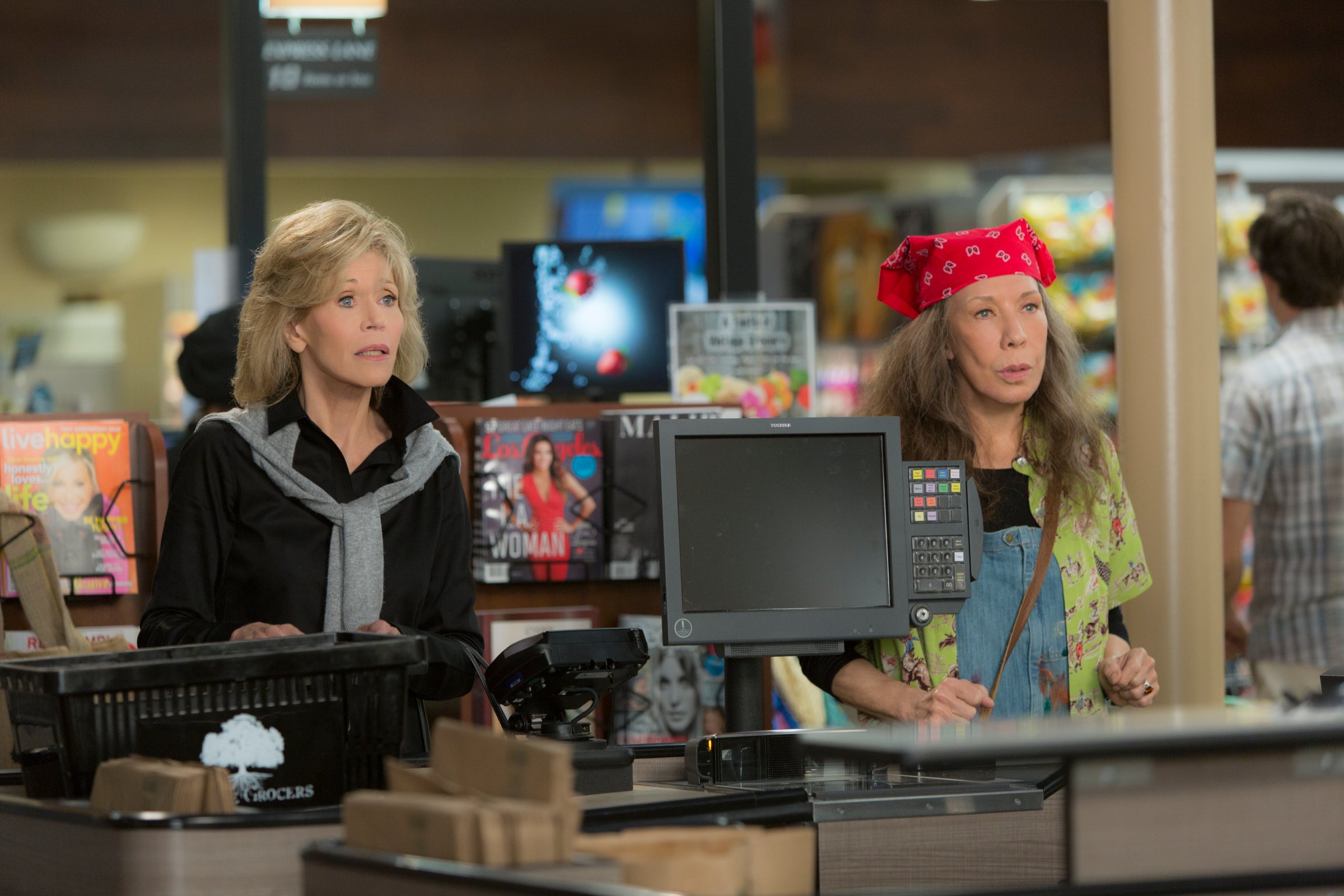
Next week, the major networks will hold their upfronts, which are important to you because that’s when they announce next season’s shows, but are important to the networks because it’s when they start to sell ads. Because advertisers pay more to reach young viewers, the networks will tout their ratings among under-35s, under-50s, under-55s. The key word is “under,” which is why you see fewer characters in the “over” age demos. (And whyseemingly 75% of TV parents had their children before age 22.)
For that reason alone, Netflix’s new comedy Grace and Frankie (premieres May 8) would be unusual even before you consider its premise: two women form an unlikely bond after their husbands announce that they are (1) gay and (2) leaving them for each other. Its quartet of stars—Jane Fonda, Lily Tomlin, Martin Sheen and Sam Waterston—are all actors in their 70s playing characters in their 70s. Even on non-ad-supported outlets like HBO and Showtime–where senior citizens’ subscription dollars are as good as the grandkids’–those are rare. (More so, in fact, than gay characters: the gay men in HBO’s late Looking and Logo’s Cucumber, say, range all the way up to the ancient 40s or 50s.)
The other way Grace and Frankie departs from what you might expect is in the title. This is not mainly the story of Robert (Sheen) and Sol (Waterston), law partners bringing their affair into the open after 20 years, but of Grace (Fonda) and Frankie (Tomlin), the wives left behind.
No-nonsense Grace and earth-mother Frankie are far from friends, but when their settlements leave them with the California beach house the couples co-owned, they become roommates. For their exes, if anything, the halo of coming out at their age makes things easier: people are so eager to be supportive, the script deftly notes, that within a week they’re having dinner with their adult children. Had their dads dumped their mothers for women, says Robert and Grace’s daughter Brianna (June Diane Raphael), “There wouldn’t be cake. There would be blood.” (Speaking of which, the opening titles, with a wedding cake collapsing over a cover of “Stuck in the Middle With You,” are instantly among the best on TV.)
Grace and Frankie, meanwhile, are left assessing the lot of newly single septuagenarian women, a class so invisible in society they have to scream to get service from a young male store clerk. (On the plus side, Frankie notes, that makes it easy to shoplift.) Frankie’s hippie om-centricity drives Grace nuts, Grace’s devotion to rules and order harshes Frankie’s mellow. Yet they stay together. There’s an ostensible reason: crazy as they make each other, they’re all they have left. But it mainly feels forced by a meta-reason: the show exists to give the 9 to 5 co-stars a chance to play off each other again. (As I wrote last week, Netflix’s programming strategy seems to be patterning shows on things people already like to stream on Netflix.)
The setup–from Marta Kauffman (Friends) and Howard J. Morris (According to Jim)–could either be the stuff of on old-fashioned odd-couple sitcom or of a Showtime-style dramedy. The hitch with the first six episodes of Grace and Frankie screened for critics is that it tries, jarringly, to be both at once.
The two stars are a delight together, especially Tomlin, who bear-hugs her role and has not lost a comic step. (Or a physical one, as when Frankie pep-talks herself by doing a vigorous power squat, crowing, “My joints are supple!”) But they play like sitcom characters plopped down in a cable-dramedy world, delivering dialogue is full of one-liners that feel like they’re setting up studio audience laughter that never comes.
Sheen and Waterston–though their pairing makes the Aaron Sorkin-protagonist slashfic you’ve always dreamed of–have the less compelling material. Robert and Sol are are also opposites (reserved and emotive, respectively), but they’ve already settled into gently bickering old-couplehood. Their biggest challenge is whether to call each other “partner” or “soulmate.” (“No!” Robert says. “I don’t even like that one when straight people use it.”) They’re most interesting in relation to their exes, each finding in his own way that, happy as he is now, there’s a part of him that mourns his longtime marriage. All this plays off the idea that the transition is easier for the men, but there’s no real spark or character development.
The comparison with Amazon’s Transparent–last year’s best series, also about a senior citizen trying to live her true sexual identity–may be unfair, but it’s glaring. That series emerged fully formed, embracing the messiness and ambiguity in its characters, and its humor and heartbreak flowed from that. Grace and Frankie is cardboardy in comparison; it feels trapped between being the show it could be in 2015 and being the show it would have been if it were made in in 1995.
Still, there’s potential. If for no other reason than that most TV is terrified of elderly characters, the show has fresh material to play with. (For instance, the introduction of seniors to both social media and sex-performance drugs, and the resulting rise in STDs.) The stars are good company to be in, and by the last of six episodes I saw in advance, its tone felt a little more consistent. All of which leaves hope that Grace and Frankie, like its title characters, is still young enough to figure out what it wants to be.
More Must-Reads From TIME
- The 100 Most Influential People of 2024
- Coco Gauff Is Playing for Herself Now
- Scenes From Pro-Palestinian Encampments Across U.S. Universities
- 6 Compliments That Land Every Time
- If You're Dating Right Now , You're Brave: Column
- The AI That Could Heal a Divided Internet
- Fallout Is a Brilliant Model for the Future of Video Game Adaptations
- Want Weekly Recs on What to Watch, Read, and More? Sign Up for Worth Your Time
Contact us at letters@time.com